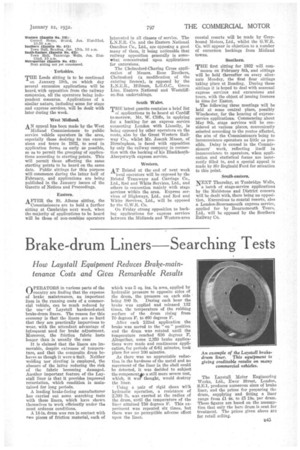Brake-drum Liners Searching Tests
Page 63

If you've noticed an error in this article please click here to report it so we can fix it.
How Laystall Equipment Reduces Brake-maintenance Costs and Gives Remarkable Results
nPERATORS in various parts of the country are finding that the expense of brake maintenance, an important item in the running costs of a commercial vehicle, can be much reduced by the use e of Laystall hardened-steel brake-drum liners. The reason for this economy is that the liners are so hard that they are practically impervious to wear, with the attendant advantage of infrequent need for brake adjustment. Moreover, the friction fabric lasts longer than is usually the case
It is claimed that the liners are immovable, despite extremes of temperature, and that the composite drum behaves as though it were a unit. Neither welding nor riveting is employed, the absence of the latter reducing the risk of the fabric becoming damaged. Another important feature of the Laystall liner is that it provides improved retardation, which condition is maintained for long periods.
A leading brake-facing manufacturer has carried out some searching tests with these liners, which have shown themselves to work efficiently under the most arduous conditions.
A 14-in, dram was run in contact with two pieces of friction material, each of which was 5 sq. ins, in area, applied by hydraulic pressure to opposite sides of the drum, the pressure on each side • being 880 lb. During each hour the brake was applied and released 132 times, the temperature of the rubbing surface of the drum rising from 70 degrees F. to 460 degrees F.
After each 132nd application the brake was moved to the " on " position and the drum was rotated until the temperature reached 630 degrees F. Altogether, some 2,350 brake applications were made and continuous application, for periods of 6-61 minutes, took place, for over 100 minutes. As there was no appreciable reduction in the hardness of the metal and no movement of the liner in the shell could be detected, it was decided to subject the cotuponento a still more severe test, which, it wag' thought, would destroy the liner.
• Using a pair of rigid shoes with hydraulic operation, a resistance of 2,300 lb. was exerted at the radius of the drum, until the temperature of the liner attained 750 degrees F. This experiment was repeated six times, but there was no perceptible adverse effect upon the liner. The Laystall Motor Engineering Works, Ltd., Ewer Street, London, S.E.1, produces numerous sizes of brake liner, and the prices for preparing the drum, supplying and fitting a liner range from 4s, to £5 18s. per drum. These figures are based on the assumption that only the bare drum is sent for treatment. The prices given above are for retail selling.




































































































